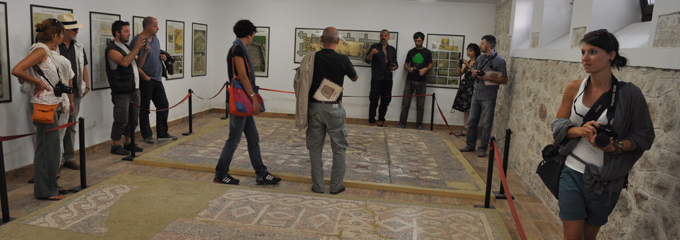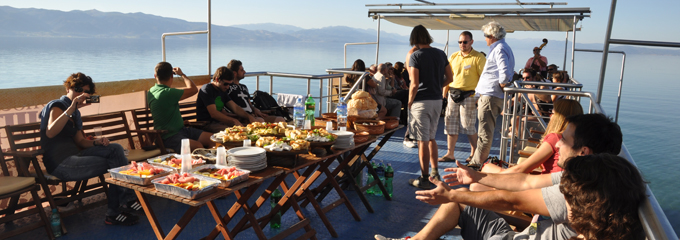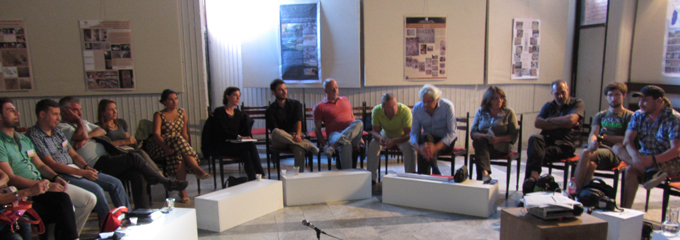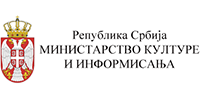
Events
SEE Mosaics V 2019 SEE Mosaics IV 2017 SEE Mosaics III 2016 SEE Mosaics II 2013 Meeting of the survey team 2011SEE Mosaics II 2013
The workshop entitled SEE Mosaics II “Forum and Workshop for Mosaic Conservation and Training of Conservators in Southeast Europe” was held from 2nd to 6th September 2013, in Ohrid, North Macedonia.

The workshop was jointly organized by the Central Institute for Conservation in Belgrade and Nikola Upevche, SEE Mosaics project team member from Ohrid , in the frame of the regional project SEE Mosaics “Second Phase: Developing network of mosaic conservation professionals and promoting mosaic heritage in SE Europe”. Efforts of the workshop were endorsed by the Central European Initiative – CEI and Local Development Agency in Struga.
The workshop participants included 28 colleagues from seven countries within the region (Albania, Bosnia and Herzegovina, Bulgaria, Croatia, North Macedonia, Serbia and Slovenia), as well as colleagues from Italy, France, Hungary and the United States.
To view complete list of participants, click here.

The workshop program consisted of individual participant presentations and round tables. The presentations showcased current developments in mosaic conservation practice in the region and reflected on related research in technology of conservation materials, documentation methods, conservation-restoration and presentation projects. On the other hand, colleagues from outside the region, presented experiences in related aspects of conservation from their work in international collaboration projects. The workshop’s round table was organized to discuss results and achievements of the first phase of the SEE Mosaics Project (Regional survey Mosaic Conservation and Training of Conservators in SE Europe), as well as to discuss the needs and possibilities for enhancing mosaics conservation in the region and to propose further courses of action within the SEE Mosaics Project. The final component of the workshop was a study visit to sites in Ohrid, sites located around Lake Ohrid, as well as archaeological sites Heraclea and Stobi.
To view workshop programme, click here.

During discussions following presentations sessions and the round table, several key points were raised by program participants:
- It is necessary to contribute to the promotion of mosaic heritage from SE Europe, as it is still not yet well-known outside the region. Additionally, the content of the SEE Mosaics website should be expanded to allow for the presentation of mosaic heritage of the region. The website should also serve to inform the public about activities regarding mosaic conservation undertaken by institutions in the region.
- Spreading and strengthening networks of mosaic conservation experts in the region should be achieved by organizing regular meetings, ideally annually.
- Participant presentations and topics of discussions during the workshop showed that the conservation practice in the region is well-developed; there are colleagues in all countries who strive to not only maintain but enhance it through their work. Joining forces through collaboration on regional projects will enable conservation professionals from the region to develop their knowledge in areas which is not their original area of expertise and, in the process, solve specific conservation problems. This manner of collaboration would be especially beneficial for the transfer and exchange of experiences between countries.
During the first round table discussion, the aim of the session was to identify areas and topics in which conservation practice should be further developed and enhanced. Proposed issues were further grouped and systemized as follows:
|
SCIENTIFIC RESEARCH IN STUDY AND CONSERVATION OF MOSAICS |
|
|
SHARING CONSERVATION DECISION |
|
|
DOCUMENTATION |
|
|
TREATMENTS |
|
|
PRESENTATION |
|
|
MANAGEMENT |
|
|
EDUCATION |
|
|
FINANCING |
|
|
RAISING AWARENESS, INVOLVEMENT OF STAKEHOLDERS |
|
SEE Mosaics Project will strive to conceptualize further activities to contribute in dealing with issues listed above.
List of presentations and posters presented at SEE Mosaics II “Forum and Workshop for Mosaic Conservation and Training of Conservators in Southeast Europe”:
PRESENTATIONS
- Nikola Upevche, academic painter mosaic artist, conservator restorer, Ohrid, “Mosaics in Ohrid”
- Bernarda Županek, Museum and Galleries of Ljubljana, Katarina Žagar, Restoration and Artistic Creation, Proprietorship, Maja Gutman, Institute for the Protection of Cultural Heritage of Slovenia, Sabina Kramar, Slovenian National Building and Civil Engineering Institute, Matjaž Bizjak, Museum and Galleries of Ljubljana, Martina Lesar Kikelj, Institute for the Protection of Cultural Heritage of Slovenia, “Museum presentation of Early Christian mosaic fragments from Roman Emona; development of light mortar for movable support(Ljubljana, Slovenia)”
- Toni Šaina, Croatian Conservation Institute, “Conservation-restoration research on floor mosaics in the St. Francis monastery and in the Cathedral (of the Assumption of Mary) in Pula, Croatia”
- Agron Islami, Institute of Cultural Monuments, Klejdi Zguro, Regional Directorate of National Culture, Tirana, “Conservation of Wall Mosaic Chapel of Roman Amphitheatre, Durrës, Albania”
- Vojin Nikolić, Nemanja Smičiklas, Institute for Protection of Cultural Monuments of Serbia Belgrade, “Mobile Platform Usage in Creating Conservation and Restoration Documentation Applied to Mosaic Example”
- Reneta Atanasova Karamanova, Regional museum of history - Stara Zagora, Bulgaria, “Conservation and Socialization of Ancient Floor Mosaics from Augusta Traiana, Stara Zagora”
- Brigitta Maria Kürtösi, Doctoral School of Hungarian University of Fine Arts, Association of Hungarian Restorers, “Original and Copy. An Archaeometrical Investigation of a Lifted Roman Mosaic Floor and the Preparation of its Copy for the Original Site,Villa Romana Baláca, Hungary”
- Bernarda Županek, Museum and Galleries of Ljubljana, Katarina Žagar, Restoration and Artistic Creation, Proprietorship, Maja Gutman, Institute for the Protection of Cultural Heritage of Slovenia, Sabina Kramar, Slovenian National Building and Civil Engineering Institute, Martina Lesar Kikelj, Institute for the Protection of Cultural Heritage of Slovenia, “Archeological parks Ljubljana, Slovenia: Emonan house, Roman wall and Early Christian Centre”
- Antonija Buljan, Croatian Conservation Institute, “Conservation-Restoration Works on Ancient Floor Mosaics of Roman Baths in Vis, Croatia”
- Patrick Blanc, L’Atelier de conservation et de restauration de mosaïques,
Musée départemental Arles antique, “Former, sauvegarder, présenter (Training, Preserving, Presenting)” - Leslie Friedman, Getty Conservation Institute, “MOSAIKON: A Strategic Initiative for the Conservation of Mosaics in the Mediterranean Region”
- Alessandro Lugari, Soprintendenza per i beni archeologici di Roma, “Mosaics in Museum: Methodology of Restoration and Usual Procedure to Mounting in Roman National Museum of Palazzo Massimo in Rome”
- Nemanja Smičiklas, Marijana Protić, Institute for Protection of Cultural Monuments of Serbia Belgrade, “Conservation, Restoration and Presentation of Mosaic Fragments from Imperial Palace, Sirmium, Sremska Mitrovica”
- Paolo Racagni, Paola Perpignani, Fondazione RavennAntica, “Séviac - Villa Gallo Romaine - Montrèal du Gers – France”
- Admir Ibričić, historian, Sarajevo, “Ancient mosaics on the territory of Bosnia and Herzegovina”
- Maja Franković, Branislava Lazarević, Central Institute for Conservation in Belgrade, “SEE Mosaics Project: Results of the Regional Survey and Possibilities for Development of the Project”
POSTERS
- Marija Zorica, Martina Rajzl, Arheological Museum in Zadar, “Conservation-restoration of the Early Christian Mosaic in Novalja”
- Antonija Buljan, Croatian Conservation Institute, “Transfering Mosaics to a Movable Support, Case Study of Early Christian Mosaic from the Basilica of St. Mary Formosa in Pula, Croatia”
- Toni Šaina, Croatian Conservation Institute, “Conservation-restoration works on the memorial ossuary and Edo Murtić's mosaic in Čazma, Croatia”
- Đeni Gobić Bravar, Archaeological Museum of Istria, “Mosaics in the Floors of the Archaeological Museum of Istria”
- Maja Franković, Dušan Maksimović, Dunja Davidović, Svetlana Gojković, Central Institute for Conservation in Belgrade, Patrick Blanc and Marie-Laure Courboulès, Musée départemental Arles antique, “Conservation of Mosaics from the National Museum in Belgrade – A Long-Term Franco-Serbian Cooperation in Training of Conservators”
- Maja Franković, Central Institute for Conservation in Belgrade, Michele Macchiarola, Institute of Science and Technology for Ceramics (CNR-ISTEC), Faenza, Nemanja Smičiklas, Republic Institute for the Protection of Monuments of Culture, Belgrade, “Research of Conservation Materials and Conservation-restoration of Mosaics from the Collection of the National Museum in Zajecar, WHS Felix Romuliana”
- Nikola Upevche, academic painter mosaic artist, conservator restorer, Ohrid, “Archaeological site St. Erasmo 1974, Archaeological Excavations of Mosaic Fragments”
- Nikola Upevche, academic painter mosaic artist, conservator restorer, Ohrid, “Archaeological Site Deboj 1978, Interventions for Detachment of Mosaic Fragments and Nartex in Roll”
- Nikola Upevche, academic painter mosaic artist, conservator restorer, Ohrid, “Archaeological Site Oktisi Church St. Nikola, Oktisi-Struga, 2009”
- Nikola Upevche, academic painter mosaic artist, conservator restorer, Ohrid, “Archaeological Site Oktisi Church St. Nikola, Oktisi-Struga, 2009-2010, Restoration Treatments on the Mosaic and Mounting on New Movable Support”
- Tome Filov, NI Stobi, Former Yugoslav Republic of Macedonia “Mosaic from the Episcopal Basilica Stobi Macedonia”
- Gorgi Dimovski, NI Institute and Museum Bitola, “Unearthening and Preventive protection of the Basilica E Nartex of the Newly Discovered Mosaic at the Site of Heraclea Lyncestis”
- Katarina Bobek, Katarina Žagar, Sara Ridički, Noemi Krase, Sanni Vuorisalo, Asparuh Mihailov, Maja Gutman, “LJUBLJANA The Emona House and Early Christian Centre Archaeological Parks”




